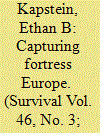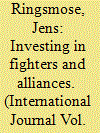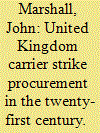| Srl | Item |
| 1 |
ID:
069763


|
|
|
|
|
| Publication |
Santa Monica, Rand Corporation, 2001.
|
| Description |
xxv, 112p.
|
| Standard Number |
0833030094
|
|
|
|
|
|
|
|
|
|
|
|
Copies: C:1/I:0,R:0,Q:0
Circulation
| Accession# | Call# | Current Location | Status | Policy | Location |
| 045091 | 358.4383072073/BIR 045091 | Main | On Shelf | General | |
|
|
|
|
| 2 |
ID:
053733


|
|
|
|
|
| Publication |
2004.
|
| Description |
p137-160
|
| Summary/Abstract |
By taking the route of international collaboration in developing and building its most advanced fighter aircraft, the Joint Strike Fighter (JSF), the US Department of Defense was seeking to ensure foreign market share, particularly in western Europe. Given the sharply falling weapons procurement budgets of the 1990s, these markets were deemed critical to the financial health of the American defence industrial base. The price of capturing those markets, however, could be high in terms of work-share and technology transfer to foreign industries and governments. The costs and benefits of international arms collaboration – specifically, the economic and security implications – need to be subject to more intensive policy analysis and public debate.
|
|
|
|
|
|
|
|
|
|
|
|
|
|
|
|
| 3 |
ID:
129828


|
|
|
|
|
| Publication |
2014.
|
| Summary/Abstract |
Building on prior work on optimal replacement of aging aircraft, this paper presents three methodologies to evaluate prospective aviation Service Life Extension Programs (SLEPs) and applies these methodologies to US Navy F/A-18E/F data. While considerable uncertainty remains as to the values of key parameters (e.g. the cost of F/A-18E/F SLEPs), the preponderance of the evidence available at this juncture favors undertaking SLEPs on F/A-18E/Fs rather than replacing them with new Joint Strike Fighters.
|
|
|
|
|
|
|
|
|
|
|
|
|
|
|
|
| 4 |
ID:
121244


|
|
|
|
|
| Publication |
2013.
|
| Summary/Abstract |
In the spring of 1975 Norway and Denmark were faced with the choice
of how to replace their aging fleets of fighter jets. Together with Belgium
and the Netherlands, the two Nordic countries had established a "buyers'
consortium" to ensure NATO standardization and a strong bargaining
position vis-à-vis the potential suppliers; hence Copenhagen and Oslo
were in very similar situations. As the final decision was about to be made,
three candidate planes were still in the competition: the American F-16, the
Swedish Saab Viggen, and the French Dassault Mirage. After a drawn-out
and exceedingly complex decision-making process, the four European NATO
members together opted for the American contender. Surely, the Danish
and Norwegian decision to procure the F-16 had several reasons behind it-
importantly, most policymakers in both Copenhagen and Oslo considered
the American aircraft to be technically superior to its competitors-but
the choice of the F-16 was in no small part motivated by old-fashioned realpolitik. The purchase of new fighter jets was thus not only perceived as a
procurement of new military equipment but also an investment in alliances
and the transatlantic link. Accordingly, Norway and Denmark chose the
American F-16 partly because this aircraft was thought to bring the greatest
strategic benefits.1
|
|
|
|
|
|
|
|
|
|
|
|
|
|
|
|
| 5 |
ID:
020392


|
|
|
|
|
| Publication |
2001.
|
| Description |
32-42
|
|
|
|
|
|
|
|
|
|
|
|
|
|
|
|
| 6 |
ID:
074717


|
|
|
| 7 |
ID:
139970


|
|
|
| 8 |
ID:
146489


|
|
|
|
|
| Summary/Abstract |
How did the Canadian news media cover the F-35 Joint Strike Fighter purchase, proposed by the Harper government in mid-2010? Under what conditions did the media tend to index government talking points as opposed to providing space to oppositional voices and viewpoints? Content analysis of headlines and full text transcripts in five mainstream newspapers revealed news coverage that was mostly negative and that it became more negative as consensus within official decision circles dissipated. Overall, the findings fit most closely with the predictions of the cascading activation model of government–media relations, while also underscoring the importance of factors specific to the Canadian context.
|
|
|
|
|
|
|
|
|
|
|
|
|
|
|
|